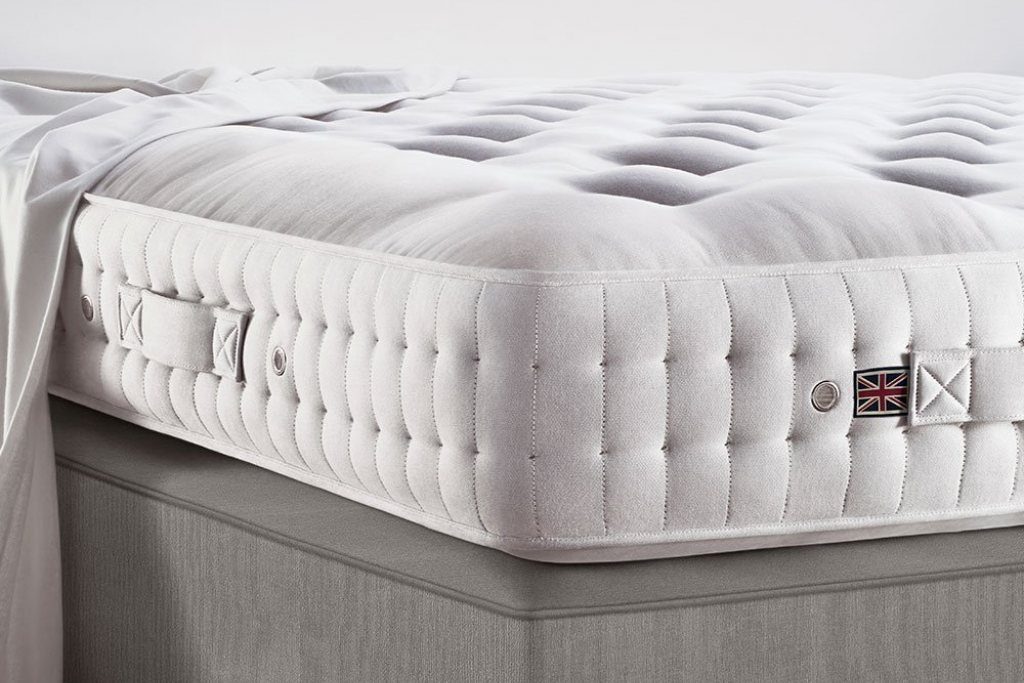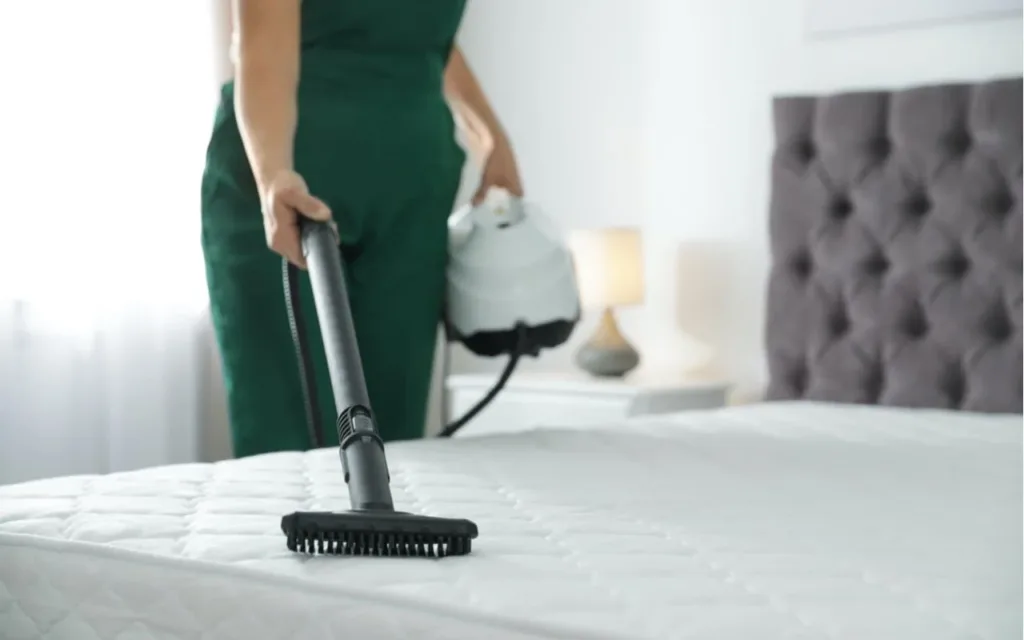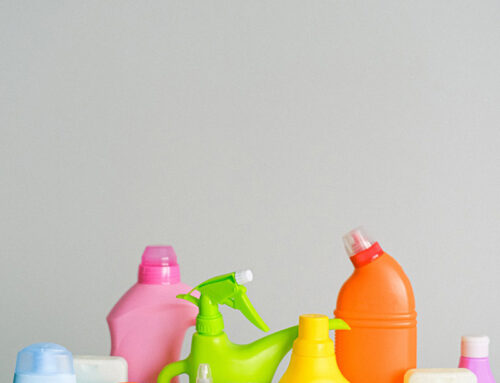You might change your sheets once or even twice every week to keep your bed fresh, but when was the last time you cleaned your mattress? Mattresses tend to see a lot of abuse from sweat, dust, and food crumbles. Yet, most of us don’t give them much thought. Figuring out how to clean mattress at home can be a game-changer in any adult’s life. In this article, you’ll find out how to deep-clean, sanitize, and preserve your mattress.
Let’s dig in!
How to Deep Clean Mattress at Home
Deep cleaning a mattress sounds tough until you break down the process into little steps.
Let’s take a look at how you can clean a used mattress in 10 simple steps:
Estimate the Degree of Soiling
Start by stripping the bed. Without the sheets and pillows, it’ll be easier to examine the bare mattress. Do you see any stains or discolourations that stand out? If so, can you guess what type of stain it is? Knowing what you’re in for will help you stay focused and organized during cleaning. It also highlights all the major problems you’ll have to deal with. For instance, seeing signs of bed bugs will change your next move.
Tackle Bed Bugs Head First
If you did spot any signs of bed bugs during your examination, don’t move forward with the deep clean until you’ve dealt with them. The simplest way to kill bed bugs is by using a chemical pyrethrin spray on the mattress and bed frame. Just make sure to wash your hands carefully and keep any pets away since pyrethrins can be toxic.
Keep in mind that the signs of bed bug infestation include the following:
- Pale yellow skin castings
- Rust-like spots
- Musty odour
Give the Mattress a Good Dusting
Before you get started with any detergents, you’ll have to handle the dust layer accumulated on either side of the mattress. You can remove this layer manually with a duster. Just make sure you’re in a well-ventilated area. Alternatively, vacuum the mattress with an upholstery attachment to save time and effort. If the vacuum sounds more convenient, that’s because it’s easy-going on your arms and back. However, the good-old duster might give you better results.
Do Spot Cleaning for Stains
Moving on, you’ll need to deal with stains and discoloured spots. The goal is to limit this step to the problem areas with the least spreading possible. If you suspect the stain is caused by blood, you’ll need to clean the spot with hydrogen peroxide. Let it sit for a few minutes, then scrub. On the other hand, regular detergent is enough for urine and sweat stains. Mix some detergent with water in a spray bottle and target the yellow areas. Let the mixture sit for 20-30 minutes before scrubbing it with a sponge.
You’ll still need to deal with the lingering scent, but we’ll get to that in a minute!
Use Enzyme-Based Cleaners
The regular spot treatment with dish soap or laundry detergent sometimes doesn’t cut it with dried stains. Enzyme-based cleaners are store-bought sprays with natural ingredients that can break down stubborn molecules like grease and blood. As a plus, most of those cleaners will come scented to mask the odour of the staining agent. On the downside, these can be expensive compared to regular detergents. They also take quite a bit of time to work.
Sanitize the Mattress With a Steamer
If you’re willing to splurge a bit, get a steam sanitiser. It’s a small handheld device that uses water vapour and heat to clean textiles in a quick and non-toxic way. The temperature on most steamers today goes around the CDC’s recommended 120°C for killing microorganisms by steam sterilization. This way, you can add an extra step along your deep cleaning program to ensure you get to any bacteria, mildew, or bugs. On the plus side, you’ll be able to use the steamer on upholstery, curtains, carpets, and even clothes!
Let the Mattress Dry in Sunlight
This step might be inconvenient for many people living in apartment complexes, but it’s highly recommended for two main reasons. For one, it’ll dry out the mattress quickly before all those liquids you’ve been spraying pool inside the mattress frame. It’ll also help reduce the smell and chance of moulding. The second reason is that the sunlight will give you a sanitizing boost by reducing the vitality of bacteria colonies. So, go the extra mile and let the freshly washed mattress stand in the sunlight for six hours. Don’t forget to flip the sides!
Deodorize the Mattress With Baking Soda
By now, your mattress should be clean, sanitized, and dry. All that’s left to do is deal with any lingering odours. Some people like getting store-bought scented sprays for textiles, but those rarely last long enough. An alternative way to deodorize your mattress is by baking soda. Just sprinkle it all over the mattress top and let it sit on the excellent part of the day. You can drop some essential oils of your choice on top of the baking soda layer, but that’s optional.
Top With a Thorough Vacuuming
Once you’re done letting the baking soda do its work, it’s time to get out your vacuum and clean up that deodorizing layer. It’ll also help suck out any remaining detergent residues from previous steps along the cleaning process. Moreover, it’ll clean up any dust that may have accumulated when you leave the mattress to dry in the sun.
Flip and Repeat
Some people prefer doing both sides together to save time. Others might work on each side separately. You might even want to target only one worn-out side of the mattress and leave the other side be. All of those options are valid as long as you give each side its due care and attention, from examination and up to the deodorizing. However, if you choose only to clean one side, flip it halfway through the sun-drying step to get some extra sanitizing throughout the mattress.
7 Tips to Keep Your Mattress Clean
Once you finish refreshing your mattress, you probably want to know how to keep it fresh until the next clean-up. Here are seven tips to help you out:
Use a Protective Cover
People get mattress toppers for various reasons, from comfort to aesthetics. However, the most benefit you’ll get from getting a mattress topper is keeping your mattress clean longer. A good-quality cover will protect your mattress from sweat staining and drink spillages. It’ll also add some years to the mattress’ expected life span. Get a waterproof one if you have young kids. It’ll save you a lot of frustration with bedtime accidents. Once you’re ready to clean your cover, remove it, pop it in the washing machine, and you’re all set!
Let Your Bed Air Out
You don’t have to wait for an unpleasant accident to care about your mattress’s condition and cleanliness. Something as simple as taking your mattress out in the sun for a quick airing can help with odour, sanitization, and mites. It’ll also be an excellent chance to spot any problem areas or staining as they form.
Change Your Sheets Often
The more sweat, dirt, and grime your sheets soak up, the more it’ll seep into your mattress surface. That’s why it’s crucial to change your sheets as a part of your regular clean-up routine. Aim to do it at least once every week. Bonus points if you use breathable bedding!
Dust and Refresh the Mattress Regularly
Deodorizing your mattress can make all the difference in how fresh it feels, and you don’t have to wait for a scheduled deep clean to do it. If your mattress is gaining an offensive odour, vacuum it, sprinkle baking soda, and vacuum again. It’s such a simple procedure with a huge impact!
Wear Both Sides Equally
Always rotate your mattress to even out the wear and tear across both sides. In some cases, mattresses are made with two seasonal faces. This means that you get one side that’s breathable and suitable for the summertime while the other is more insulating for the cold winter nights. So, check the manufacturer’s rotating recommendations. If there are none, do it once every six months.
Get the Air Conditioner Going
If you tend to sweat a lot through the night, you’ll risk straining the mattress and accumulating a foul odour very quickly. Consider adjusting the room temperature to keep your bedding clean longer. It’ll also reduce the muskiness of your bedroom significantly.
Keep the Contaminants Away
We get that it can be pretty tempting to eat and drink in bed; for the most part, there’s no harm in doing that. The problems start when you’re being careless. Just make sure you clean up any food crumbles or spillages as soon as they happen. After all, dealing with still-wet stains is much less hassle than cleaning up dried and soaked ones.
When to Get Professional Help
DIYing your cleaning chores is all good for your wallet, but knowing when to leave it to the pros is also essential.
Mould Infestation
If you can visibly see moulding on the textile on top of the mattress, the odds are that the entire thing is infested all through its frame. It might be safer to consult a professional cleaning service in cases like this. Just keep in mind that the hassle of cleaning it thoroughly might not be worth its value in the end.
Allergies
People with severe allergies might be unable to handle cleaning their mattresses at home. Instead, professional intervention could save the day. Remember that many allergens can seep into the fabric, including dust, pollen, and bed bugs.
FAQs
Here are some of the most frequently asked questions about cleaning used mattresses:
Q: How often should you clean a mattress?
A: Ideally, your mattress can benefit from cleaning twice a year. You can supplement those two deep cleans with periodic airing and deodorizing once every two months.
Q: How often should you replace your mattress?
A: The Sleep Foundation recommends that you flip your mattress every 6-8 years. However, that number isn’t always fixed.
It would help if you replaced your mattress when you feel like it’s lost most of its support and you’re no longer getting a good night’s rest.
Q: Do mattresses double in weight after 10 years?
A: People often hear that after 10 years of wear and tear, the mattress will double in weight since it will have absorbed too much debris from dead skin cells. Mites then colonize around this debris, or that’s how the myth goes.
A used mattress might have millions of mites inside it, and it’s bound to increase a bit in weight. However, to say that it’ll double in weight is a bit of a reach with no scientific backing.
Q: Does rotating a mattress help with longevity?
A: Yes, rotating a mattress can extend its lifespan by evenly distributing the wear and tear throughout the mattress fibres.
That’s why it’s highly recommended that you flip your mattress now and then from top to bottom and sideways.
Q: Is it okay to get a second-hand mattress?
A: Getting second-hand items can be a lifesaver when you’re on a budget, and mattresses are no exception. You can get one in decent shape for 20-30% of its original price tag, which is convenient for many people.
On the downside, you can’t guarantee how clean it is unless you buy from reputable retailers. You’ll still have to sanitize it with a steamer and let air in the sun for good measure.
Final Thoughts
Overall, figuring out how to clean a mattress at home is not all that challenging. It all comes down to identifying the main problems and targeting them one at a time. You can refresh your mattress and extend its life span in only a few steps. Remember that the more care you give your bedding, the more comfortable you’ll get in return!








